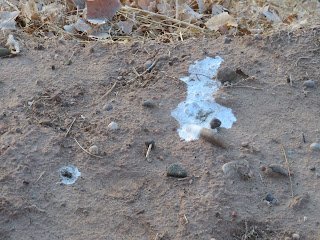This picture shows the wiry black occipital feathers that form part of the breeding plumage on the back of the head. Herons in large groups have a very complex range of courtship behaviors that we never get to see in Corrales. Best I can tell, during breeding season we have a few bachelors in this area. The situation would be different if we had more acres of wetland meadows. The nearest heronry I can find is near the Pecos river, in western NM.
People who visit semi-rural Corrales from the cities comment on the many of the wonderful sights here. But something that always gets commented on is the amount of feces lying around. I always chuckle at this because if they only knew the half of it... the stories of raccoon roundworm parasites, domestic dogs, the work that goes into dog poop pick up stations in the bosque preserve, the issues around horse manure and removal by municipal authorities... Everyone seems to love a good poop story and there are a lot of them. For example, coyotes and dogs are both attracted to horse droppings. This is bad, because horses and their dung can accumulate Ivermectin used for worm control, which will eventually cause many deadly symptoms in dogs, either medium sized dogs on walks, or larger dogs on farms that have access to a constant supply.
Fallen fruit attracts coyotes as well. The scat coyotes drop at along marking trails is almost exclusively apple right now. The yellow/brown color is very different than the dark/brown, stinky, and slimy scat of domestic dogs (pick up after your pets)
Birds feeding on fish usually drop liquid splashes of white near to their roost spots. Most birds defecate right as they take off, to reduce weight. Another species of heron is called a "shitepoke" because they defecate when disturbed in long grass. The name got changed by the time the reference made it into "Hamlet", according to Wikipedia.
It is kind of rare to find a heron still fishing in the morning, as they are pretty easily disturbed by people's activities. However, they do not restrict their activities to fishing. Great heron are famous for hunting almost anything they can swallow.
Some of the small white pebbles in the dirt near Meadowlark and Andrews Lane is actually the regurgitated meal of an owl. The long incisor in the top and bottom right of this picture are the classic signs of gopher. They are one of the most common prey items in owl diets.
This pile of gold fur confused me for a while. I'm pretty sure now that it was a gopher as some point in the past.
Its hard to say what killed this gopher, but there are many ways people have tried (and failed). It's a bit concerning to be finding so many signs of dead gopher around. There is also a definite increase in pest control companies in Corrales willing to take people's money for an essentially never-ending problem. Given how much the ecosystem relies on these rodents I sincerely hope someone isn't poisoning these animals. It can be terrifying to watch a normally mild mannered gardener, equestrian, or wildlife manager go from rational human, into a snarling predator when talking about being defeated by a furry pair of orange teeth. The pest control companies should know better, but everyone knows we are under pretty strong pressure in these times to produce results. When poisons are used, it is just too easy to not do things correctly. Home owners often try to save a buck and some time by doing things themselves. Most people in the pest control business that I have met love animals far more than their customers. I suspect this one was caught by a domestic cat based on all the marks on the belly









No comments:
Post a Comment